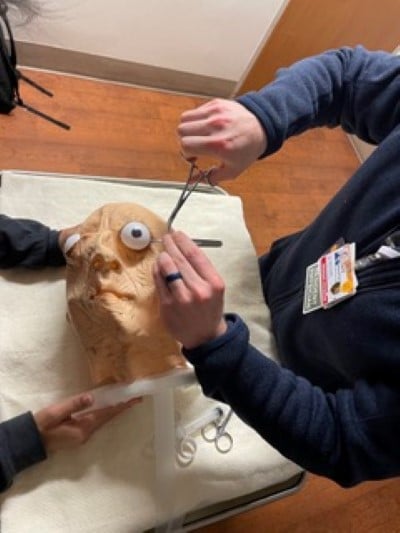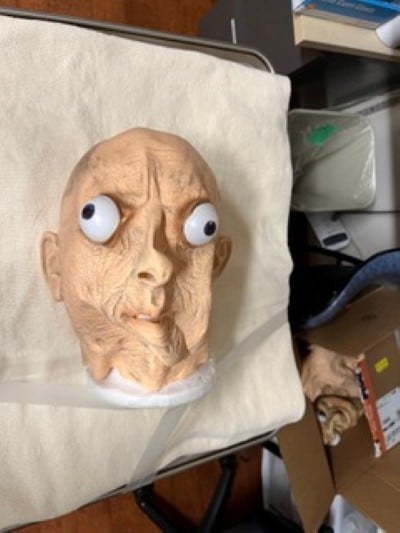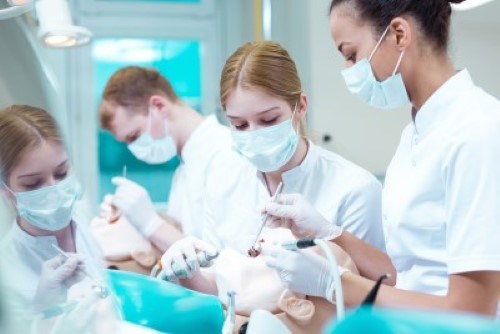The art of on-shift teaching is a skill that many attendings struggle with and aim to master, especially during a busy shift.
Limited research on this topic shows that approximately 6-20% of attendings teach during a shift. Even fewer studies characterize their teaching methods. One study showed that 25% of attendings taught on shift, with a majority of their techniques involving implicit teaching during patient-care discussions.1 While this is an important approach, we believe that providing additional tools for educators can enhance medical education.
Enter: The “Sim Gym.” It’s a novel concept — a portable task trainer for explicit, dedicated teaching of EM procedures.
Although published data on in-situ procedure training is limited, one study within U.K. medical literature highlighted a “tea trolley” being brought into an anesthesia resident workroom to teach residents difficult airway skills.2
We felt that a similar concept could be used in our ED by utilizing a portable trainer to teach procedures. We started with the lateral canthotomy. Lateral canthotomy is an example of a low-frequency, but high-risk, procedure that emergency physicians need to feel comfortable to perform. We wanted to improve the proficiency in performing a lateral canthotomy in the emergency department, as well as review indications and contraindications for this procedure. Due to limited real-patient experience of this type of procedure during a typical EM residency, it lends itself well to simulated training. The Sim Gym, as a portable task trainer, can easily be accessed during shifts to serve as an additional tool for educators and allow hands-on training for procedures such as the lateral canthotomy.
Design
Goal: Create a portable, low-fidelity lateral canthotomy model, train residents while working on shift, and collect pre- and post-intervention data on proficiency.
Eligibility: All emergency medicine residents (PGY1-PGY3) working in the emergency department around 12 pm on Jan. 31, 2022, and Feb. 1, 2022.
Pre-intervention: A qualitative discussion assessing knowledge of indications, complications, and contraindications was performed prior to the intervention.
Intervention:
- Over the course of two emergency department shifts (11 am-9 pm), 11 PGY1-3 EM residents participated in a 10-15 minute, one-on-one simulated session involving performing a lateral canthotomy.
- A simulation case was created involving a trauma where a lateral canthotomy was indicated.
- We created a Sim Gym that had multiple low-fidelity lateral canthotomy models using halloween masks, ping pong balls, and sutured in hair ties as described in the Nadir et al paper.3
Post-intervention:
- A SurveyMonkey questionnaire consisting of seven questions was completed by participating residents after the intervention to assess knowledge retention.
- An educational guide was emailed to all participating residents discussing indications, complications, contraindications, and procedure steps for a lateral canthotomy.
Results
The post-intervention questionnaire included inquiries regarding comfort level of performing a lateral canthotomy; indications, contraindications and complications of the procedure; usefulness of the model; usefulness for on-shift education; and additional feedback. (See Table 1.)
Table 1: Knowledge and proficiency in EM residents (n=11) pre- and post-intervention.
|
Survey Question |
Pre-survey (n = 11) |
Post-survey (n =11) |
|
Indications for lateral canthotomy |
100% |
100% |
|
Contraindications |
36% |
82% |
|
Complications |
18% |
82% |
|
Usefulness of procedure model |
0% |
45% extremely 27% very useful 27% somewhat useful |
|
Comfort level after workshop |
0% |
64% very confident 36% somewhat confident |
|
Usefulness for on-shift resident education |
N/A |
18% extremely useful 55% very useful 27% somewhat useful |
Additional feedback from our study’s resident-participants included, “Consider hosting ‘sim gym’ training during a less busy clinical time,” and, “Consider distribution of a smart-card that outlines the highlights of the procedure” to facilitate retention.
Discussion
In medical education, simulation is a useful tool that encourages team building and problem solving in a safe environment. Although simulation occurs every month during our formal scheduled didactic sessions in the St. Joseph’s Medical Center Sim Lab, mock in-situs and on-shift simulation-based teaching are beneficial adjuncts. The theory behind these on-shift events is that training in the actual ED increases fidelity, provides a unique experience that triggers memory formation and future recall, improves patient safety, and serves as a fun and enjoyable outlet during otherwise stressful patient-care activities.4
During our two-day intervention, there was significant improvement in the comfort level of EM residents performing a lateral canthotomy, ranging from 36-64% feeling somewhat to very confident. During the pre-intervention discussion, all residents stated they had never performed one in their training to date.


All residents knew the indications for a lateral canthotomy. There was a 2.3-fold improvement (from 36% to 82% of residents) in knowing contraindications for lateral canthotomy. In addition, after the Sim Gym intervention, there was a 4.6-fold increase (from 11% to 82% of residents) in knowing the complications of a lateral canthotomy.
Residents reported that their comfort level improved after the simulation exercise, and knowledge of the procedure was generally high as ascertained on the post-intervention survey.
Limitations
Limitations of this study included the small sample size as well as the short duration of time over which this study was conducted. In addition, the pre-survey data was collected through an informal discussion during the intervention, as opposed to through a formal survey.
Conclusion
The portable Sim Gym is a novel and innovative modality that facilitates dedicated, on-shift resident education and provides a tangible resource that attendings can use for explicit teaching. This versatile, portable trainer can be used for various EM procedures. It would be especially useful in training for low-frequency/high-risk procedures and would encourage increased exposure, repetition, and memory retention. Future studies could include retention and proficiency in other EM procedures, more qualitative pre-intervention collection of data, a larger sample size through a longer period of time, and feedback from on-shift attending physicians to assess the feasibility and usefulness of the task trainer.
Additional Resources
- https://www.ncbi.nlm.nih.gov/pmc/articles/PMC7972397/
- https://www.aliem.com/idea-series-on-shift-google-docs/
- https://emergencymedicinecases.com/teaching-on-shift/
- https://www.aliem.com/2017/01/post-it-pearls-bedside-teaching/.
- https://www.ncbi.nlm.nih.gov/books/NBK557695/
References
- Baugh JJ, Monette DL, Takayesu JK, Raja AS, Yun BJ. Types and Timing of Teaching During Clinical Shifts in an Academic Emergency Department. West J Emerg Med. 2021;22(2):301–307.
- O’Farrell G, McDonald M, Kelly FE. “Tea trolley” difficult airway training. Anaesthesia. 2015;70,104.
- Nadir N, Sattar I, Ahmed A. The halloween lateral canthotomy model. JETem. 2017;2(2):I17-20.
- Davis D, Warrington SJ. Simulation Training and Skill Assessment in Emergency Medicine. StatPearls. 2021 May 9.



